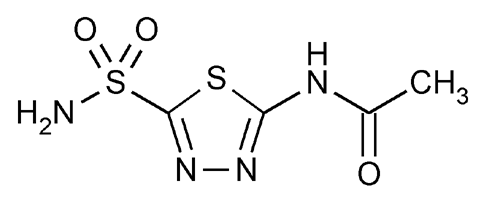Acetazolamide
Acetamide, N-[5-(aminosulfonyl)-1,3,4-thiadiazol-2-yl]-.
N-(5-Sulfamoyl-1,3,4-thiadiazol-2-yl)acetamide
» Acetazolamide contains not less than 98.0 percent and not more than 102.0 percent of C4H6N4O3S2, calculated on the anhydrous basis.
Packaging and storage—
Preserve in tight containers, and store at room temperature.
Identification—
B:
Dissolve about 100 mg in 5 mL of 1 N sodium hydroxide. Add 5 mL of a solution made by dissolving 100 mg of hydroxylamine hydrochloride and 80 mg of cupric sulfate in 10 mL of water. Mix, and heat the resulting pale yellow solution on a steam bath for 5 minutes: a clear, bright yellow solution is produced. No heavy precipitate or dark brown color results after the mixing or heating.
Water, Method I  921
921 :
not more than 0.5%.
:
not more than 0.5%.
Residue on ignition  281
281 :
not more than 0.1%.
:
not more than 0.1%.
Chloride  221
221 —
Digest 1.5 g with 75 mL of water at about 70
—
Digest 1.5 g with 75 mL of water at about 70 for 5 minutes. Cool to room temperature, and filter: a 25-mL portion of the filtrate shows no more chloride than corresponds to 0.10 mL of 0.020 N hydrochloric acid (0.014%).
for 5 minutes. Cool to room temperature, and filter: a 25-mL portion of the filtrate shows no more chloride than corresponds to 0.10 mL of 0.020 N hydrochloric acid (0.014%).
Sulfate  221
221 —
A 25-mL portion of the filtrate prepared in the test for Chloride shows no more sulfate than corresponds to 0.20 mL of 0.020 N sulfuric acid (0.04%).
—
A 25-mL portion of the filtrate prepared in the test for Chloride shows no more sulfate than corresponds to 0.20 mL of 0.020 N sulfuric acid (0.04%).
Selenium  291
291 :
0.003%, a 200-mg specimen being used.
:
0.003%, a 200-mg specimen being used.
Heavy metals, Method II  231
231 :
0.002%.
:
0.002%.
Silver-reducing substances—
Thoroughly wet 5.0 g with alcohol. Add 125 mL of water, 10 mL of nitric acid, and 5.0 mL of 0.1 N silver nitrate VS. Stir with a mechanical stirrer for 30 minutes. Filter, add 5 mL of ferric ammonium sulfate TS to the filtrate, and titrate with 0.1 N ammonium thiocyanate VS to a reddish-brown endpoint: not less than 4.8 mL of 0.1 N ammonium thiocyanate is required.
Ordinary impurities  466
466 —
—
Test solution:
a mixture of acetone and methanol (1:1).
Standard solution:
a mixture of acetone and methanol (1:1).
Eluant:
a mixture of n-propyl alcohol and 1 N ammonium hydroxide (88:12).
Visualization:
1.
Assay—
Dissolve about 200 mg of Acetazolamide, accurately weighed, in a small volume of pyridine in a 10-mL volumetric flask, add the solvent to volume, and mix. Similarly, dissolve an accurately weighed quantity of USP Acetazolamide RS in pyridine to obtain a Standard solution having a known concentration of about 20 mg per mL. Concomitantly determine the absorbances of both solutions in 0.1-mm cells at the wavelength of maximum absorbance at about 7.38 µm (1350 cm 1), with a suitable IR spectrophotometer, using pyridine as the blank. Calculate the quantity, in mg, of C4H6N4O3S2 in the portion of Acetazolamide taken by the formula:
1), with a suitable IR spectrophotometer, using pyridine as the blank. Calculate the quantity, in mg, of C4H6N4O3S2 in the portion of Acetazolamide taken by the formula:
10C(AU / AS)
in which C is the concentration, in mg per mL, of USP Acetazolamide RS in the Standard solution; and AU and AS are the absorbances of the solution of Acetazolamide and the Standard solution, respectively.
Auxiliary Information—
Please check for your question in the FAQs before contacting USP.
Chromatographic Column—
| Topic/Question | Contact | Expert Committee |
| Monograph | Feiwen Mao, M.S.
Scientist 1-301-816-8320 |
(MDOOD05) Monograph Development-Ophthalmics Oncologics and Dermatologicals |
| Reference Standards | Lili Wang, Technical Services Scientist 1-301-816-8129 RSTech@usp.org |
USP32–NF27 Page 1417
Pharmacopeial Forum: Volume No. 27(3) Page 2500
Chromatographic columns text is not derived from, and not part of, USP 32 or NF 27.
